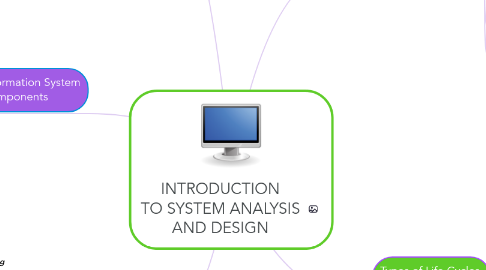
1. System Development Methods
1.1. Structured Analysis
1.1.1. Systems development life cycle (SDLC)
1.1.2. Process-centered technique
1.1.3. Waterfall model
1.1.3.1. Multilevel
1.1.3.1.1. Name, Category, Price etc
1.2. Object Oriented Analysis
1.2.1. Object is a member of a class
1.2.2. Objects possess properties
1.2.3. Methods change an object’s properties
1.2.4. Interactive model
1.3. Agile/Adaptive Method
1.3.1. Are the newest development
1.3.2. Emphasizes continuous feedback
1.3.3. Iterative development
1.3.4. Spiral Model
2. Information System Components
2.1. Resources of people
2.1.1. End users
2.1.1.1. ns1.oldnamserver
2.1.1.2. ns2.oldnamserver
2.1.2. System analyst
2.1.2.1. ns1.newnamserver
2.1.2.2. ns2.newnamserver
2.1.3. Programmers
2.1.4. Database Administrator
2.2. Hardware
2.2.1. Computer equipments
2.2.2. Associate device
2.2.3. Machines
2.3. Software
2.3.1. Programs
2.3.2. Procedure
2.4. Data
2.5. Network
2.5.1. Communications media
2.5.2. Network support
3. Types of Information System
3.1. Transaction Processing System
3.1.1. For business transactions involving the collection, modification and retrieval of all transaction data
3.2. Management Information System
3.2.1. Focuses on the management of information systems to provide efficiency and effectiveness of strategic decision making
3.3. Desicion Support System
3.3.1. Computer program application that analyzes business data and presents it so that users can make business decisions more easi
4. Types of Life Cycles Model
4.1. Waterfall Model
4.1.1. Each phase must be completed before the next phase can begin
4.1.1.1. Content
4.1.1.2. 1 image per post
4.2. Spiral Model
4.2.1. Emphasizes the need to go back and reiterate earlier stages a number of times as the project progresses.
4.3. Iterative and incremental development
4.3.1. Iteratively enhances the evolving versions until the complete system is implemented
4.4. Agile Model
4.4.1. Combination of iterative and incremental process models with focus on process adaptability and customer satisfaction
4.5. Prototyping Model
4.5.1. Building software application prototypes which display the functionality of the product under development
4.6. Rapid Application Development (RAD)
4.6.1. Attempts to create an application more quickly through strategies that include fewer formal methodologies and reusing software components.
4.7. Joint Application Development (JAD)
4.7.1. Methodology aims to involve the client in the design and development of an application
4.8. Extreme Programming (XP)
4.8.1. Extreme Programming is an approach to software development put together
5. System Development Life Cycle (SDLC)
5.1. Planning
5.1.1. Desired features and operations in detail
5.2. Analyze
5.2.1. The analyst finds the problem in the company and submits a solution
5.3. Design
5.3.1. Describes desired features including screen layouts, process diagrams, and other documentation.
5.4. Development
5.4.1. A programmer, data base developer and a network engineer working together to develop system.
5.5. Testing
5.5.1. To ensure workability and combines all the system into a special testing environment, then checks for errors and bugs
5.6. Implementation
5.6.1. Installation of systems components and old data is moved to new system
5.7. Maintenance
5.7.1. Updates, changes, correction, additions, and moves are made
